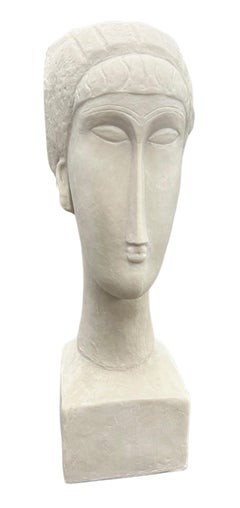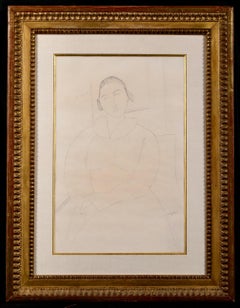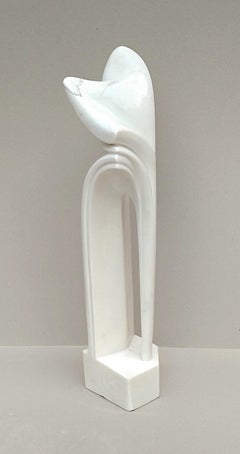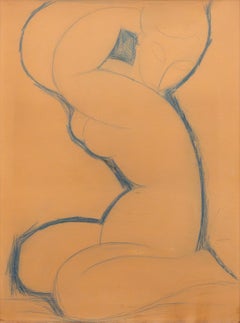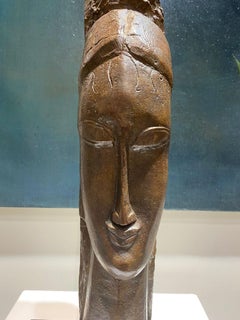Amedeo Modigliani Art
to
1
1
Overall Width
to
Overall Height
to
2
1
2
1
2
2
1
1
1
1
1
4
8,227
2,805
2,504
1,656
1
1
1
Artist: Amedeo Modigliani
Tete de Femme III, Modern Cast Stone Sculpture by Amedeo Modigliani
By Amedeo Modigliani
Located in Long Island City, NY
Amedeo Modigliani, Italian (1884 - 1920) - Tete de Femme III, Medium: Cast Stone Sculpture, Size: 22 x 6.5 x 5.5 in. (55.88 x 16.51 x 13.97 cm), Publisher: Austin Productions
Category
Mid-20th Century Modern Amedeo Modigliani Art
Materials
Stone
Portrait of Berthe Lipchitz - Modern Portrait Pencil Drawing - Amedeo Modigliani
By Amedeo Modigliani
Located in Marlow, Buckinghamshire
Signed pencil on paper portrait drawing by Italian artist Amedeo Clemente Modigliani. The portrait is of Berthe Lipchitz who was the wife of Modigliani's friend, the sculptor Jacques...
Category
1910s Modern Amedeo Modigliani Art
Materials
Paper, Pencil
Related Items
French Modern Drawing by Jean Hélion - Veil Homme
By Jean Hélion
Located in Paris, IDF
Veil Homme
1947
drawing
26,9 x 21 x 0,1 cm
Registered on the catalogue raisonné with inventory number : N°0252 cat. B
sold without frame
about Jean Hélion (April 21, 1904 – October ...
Category
1960s Modern Amedeo Modigliani Art
Materials
Pencil, Paper
$2,000
H 10.6 in W 8.27 in D 0.04 in
Arch, Sensual White Carrara Statuary Marble Stone Vertical Figurative Sculpture
By Lutfi Romhein
Located in Clermont-Ferrand, Auvergne-Rhône-Alpes
This Carrare statuary marble stone sculpture in a very pure white with slightly colored veins is by Lutfi Romhein.
A graduate from the Academy of Fine A...
Category
2010s Modern Amedeo Modigliani Art
Materials
Marble
$5,973
H 27.56 in W 5.52 in D 4.73 in
1940s Charcoal and Pencil Portrait of a Man
Located in Arp, TX
Artist Unknown
"Tie and Glasses"
c. 1940s
Charcoal and pencil on paper
13.5"x17" site 19"x23" rustic wood frame
Unsigned
Category
1940s Modern Amedeo Modigliani Art
Materials
Paper, Charcoal, Carbon Pencil
Black Panther Trials - Civil Rights Movement Police Violence African American
Located in Miami, FL
The Black Panther Trials - In this historically significant work, African American Artist Vicent D. Smith functions as an Art Journalist/ Court Reporter as much as a
Artist. Here, he depicts, in complete unity, 21 Black Panther Protestors raising their fist of defiance at the White Judge. Smith's composition is about utter simplicity, where the Black Panther Protestors are symmetrically lined up in a confrontation with a Judge whose size is exaggerated in scale. Set against a stylized American Flag, the supercilious Judge gazes down as the protesters as their fists thrust up. Signed Vincent lower right. Titled Panter 21. Original metal frame. Tape on upper left edge of frame. 255 . Panther 21. Framed under plexi.
_____________________________
From Wikipedia
In 1969-1971 there was a series of criminal prosecutions in New Haven, Connecticut, against various members and associates of the Black Panther Party.[1] The charges ranged from criminal conspiracy to first-degree murder. All charges stemmed from the murder of 19-year-old Alex Rackley in the early hours of May 21, 1969. The trials became a rallying-point for the American Left, and marked a decline in public support, even among the black community, for the Black Panther Party
On May 17, 1969, members of the Black Panther Party kidnapped fellow Panther Alex Rackley, who had fallen under suspicion of informing for the FBI. He was held captive at the New Haven Panther headquarters on Orchard Street, where he was tortured and interrogated until he confessed. His interrogation was tape recorded by the Panthers.[2] During that time, national party chairman Bobby Seale visited New Haven and spoke on the campus of Yale University for the Yale Black Ensemble Theater Company.[3] The prosecution alleged, but Seale denied, that after his speech, Seale briefly stopped by the headquarters where Rackley was being held captive and ordered that Rackley be executed. Early in the morning of May 21, three Panthers – Warren Kimbro, Lonnie McLucas, and George Sams, one of the Panthers who had come East from California to investigate the police infiltration of the New York Panther chapter, drove Rackley to the nearby town of Middlefield, Connecticut. Kimbro shot Rackley once in the head and McLucas shot him once in the chest. They dumped his corpse in a swamp, where it was discovered the next day. New Haven police immediately arrested eight New Haven area Black Panthers. Sams and two other Panthers from California were captured later.
Sams and Kimbro confessed to the murder, and agreed to testify against McLucas in exchange for a reduction in sentence. Sams also implicated Seale in the killing, telling his interrogators that while visiting the Panther headquarters on the night of his speech, Seale had directly ordered him to murder Rackley. In all, nine defendants were indicted on charges related to the case. In the heated political rhetoric of the day, these defendants were referred to as the "New Haven Nine", a deliberate allusion to other cause-celebre defendants like the "Chicago Seven".
The first trial was that of Lonnie McLucas, the only person who physically took part in the killing who refused to plead guilty. In fact, McLucas had confessed to shooting Rackley, but nonetheless chose to go to trial.
Jury selection began in May 1970. The case and trial were already a national cause célèbre among critics of the Nixon administration, and especially among those hostile to the actions of the FBI. Under the Bureau's then-secret "Counter-Intelligence Program" (COINTELPRO), FBI director J. Edgar Hoover had ordered his agents to disrupt, discredit, or otherwise neutralize radical groups like the Panthers. Hostility between groups organizing political dissent and the Bureau was, by the time of the trials, at a fever pitch. Hostility from the left was also directed at the two Panthers cooperating with the prosecutors. Sams in particular was accused of being an informant, and lying to implicate Seale for personal benefit.
In the days leading up to a rally on May Day 1970, thousands of supporters of the Panthers arrived in New Haven individually and in organized groups. They were housed and fed by community organizations and by sympathetic Yale students in their dormitory rooms. The Yale college dining halls provided basic meals for everyone. Protesters met daily en masse on the New Haven Green across the street from the Courthouse (and one hundred yards from Yale's main gate). On May Day there was a rally on the Green, featuring speakers including Jean Genet, Abbie Hoffman, Jerry Rubin, and John Froines (an assistant professor of chemistry at the University of Oregon). Teach-ins and other events were also held in the colleges themselves.
Towards midnight on May 1, two bombs exploded in Yale's Ingalls Rink, where a concert was being held in conjunction with the protests.[4] Although the rink was damaged, no one was injured, and no culprit was identified.[4]
Yale chaplain William Sloane Coffin stated, "All of us conspired to bring on this tragedy by law enforcement agencies by their illegal acts against the Panthers, and the rest of us by our immoral silence in front of these acts," while Yale President Kingman Brewster Jr. issued the statement, "I personally want to say that I'm appalled and ashamed that things should have come to such a pass that I am skeptical of the ability of a Black revolutionary to receive a fair trial anywhere in the U.S." Brewster's generally sympathetic tone enraged many of the university's older, more conservative alumni, heightening tensions within the school community.
As tensions mounted, Yale officials sought to avoid deeper unrest and to deflect the real possibility of riots or violent student demonstrations. Sam Chauncey has been credited with winning tactical management on behalf of the administration to quell anxiety among law enforcement and New Haven's citizens, while Kurt Schmoke, a future Rhodes Scholar, mayor of Baltimore, MD and Dean of Howard University School of Law, has received kudos as undergraduate spokesman to the faculty during some of the protest's tensest moments. Ralph Dawson, a classmate of Schmoke's, figured prominently as moderator of the Black Student Alliance at Yale (BSAY).
In the end, compromises between the administration and the students - and, primarily, urgent calls for nonviolence from Bobby Seale and the Black Panthers themselves - quashed the possibility of violence. While Yale (and many other colleges) went "on strike" from May Day until the end of the term, like most schools it was not actually "shut down". Classes were made "voluntarily optional" for the time and students were graded "Pass/Fail" for the work done up to then.
Trial of McLucas
Black Panther trial sketch...
Category
1970s American Modern Amedeo Modigliani Art
Materials
Watercolor, Pen, Pencil, Paper
Mon Colonel
By Auguste Chabaud
Located in London, GB
'Mon Colonel', pencil and crayon on paper, by noted French artist, Auguste Chabaud (circa 1914-1918). A delightfully simple drawing of a French Army colonel in profile along with clo...
Category
1910s Modern Amedeo Modigliani Art
Materials
Paper, Crayon, Pencil
Bronze Bowl With Marble and Wood Sculpture
Located in Lake Worth Beach, FL
Bronze Marble Wood Sculpture
Four separate pieces, unsigned artist Sarah Schwartz was born 1953 Chicago, Illinois.
Education: 1971-72 York University/Ontario College of Art, Toronto...
Category
1980s American Modern Amedeo Modigliani Art
Materials
Marble, Bronze
Young man in a toga elegant man Latin American hyperrealist Hockney style
By Claudio Bravo
Located in Norwich, GB
Superb original drawing in coloured conté pencils, heightened with white on oatmeal coloured vergé paper by Claudio Bravo. The work was created during the artist's Moroccan period, a...
Category
1970s Modern Amedeo Modigliani Art
Materials
Conté, Laid Paper, Color Pencil
$7,500
H 30.32 in W 24.02 in D 0.4 in
Sydney Kumalo Bronze Minimalist African Modernist Sculpture Figural Female Nude
Located in Surfside, FL
Sydney Kumalo. Features a bronze stylized female figural form sculpture fixed to a marble plinth and wood base. Bears signature on base. Measures 9 1/2" x 4 1/4". There is no edition number on the piece.
Sydney Kumalo (1935 - 1988) was born in Sophiatown, Johannesburg, on 13 April 1935. His was one of the families who had to move out of the "white" city to the South Western Townships, or Soweto. Raised in Diepkloof and educated at Madibane High School, he took with him from old Sophiatown the curious and diverse heritage of its heyday. Art classes in the Catholic school, "Sof' town" blues and jazz, the vibrant street culture and growing defiance of its population of various races who were gradually forced out into separate race-group areas. So it was that these various aspects of his early life created for Kumalo a cultural mix of a Zulu family related to the traditional royal house; city schooling, nascent township music and lingo; growing urbanised political defiance and the deep-rooted Zulu pride and respect for the legends and ancient stories of a tribal people. This mix of old and new cultures was reinforced when he began his studies at the Polly Street Art Centre in 1953 where he became a member of Cecil Skotnes group of serious artists who were encouraged to acquire professional skills. Skotnes introduced a basic training programme with modelling as a component, which marked the introduction of sculpting (in brick-clay) at Polly Street.
Kumalo was Skotnes’ assistant at Polly Street from 1957 to 1964, and having recognised his great talent as a sculptor, Skotnes encouraged him to become a professional artist.
After Kumalo’s very successful assistance with a commission to decorate the St Peter Claver church at Seeisoville near Kroonstad, with painting designs, sculpture and relief panels in 1957, Skotnes arranged for Kumalo to continue his art training by working in Edoardo Villa ’s studio from 1958 to 1960. Working with Villa, he received professional guidance and began to familiarize himself with the technical aspects of sculpting and bronze casting. In 1960 he became an instructor at the Polly Street Art Centre.
Kumalo started exhibiting his work with some of the leading commercial Johannesburg galleries in 1958, and had his first solo exhibition with the Egon Guenther Gallery in 1962. He was a leader of the generation who managed to leave behind the forms of African curios, reject the European-held paternalism which encouraged notions of "naive" and "tribal" African art, and yet still hold fast to the core of the old legends and spiritual values of his people. He introduced these subjects into his bronze sculptures and pastel drawings, evolving his own expressive, contemporary African "style".
Together with Skotnes, Villa, Cecily Sash and Giuseppe Cattaneo, Kumalo became part of the Amadlozi group in 1963. This was a group of artists promoted by the African art collector and gallery director Egon Guenther, and characterised by their exploration of an African idiom in their art. Elza Miles writes that Cecil Skotnes’ friendship with Egon Guenther had a seminal influence on the aspirant artists of Polly Street: “Guenther broadened their experience by introducing them to German Expressionism as well as the sculptural traditions of West and Central Africa. He familiarised them with the work of Ernst Barlach, Käthe Kollwitz, Gustav Seitz, Willi Baumeister and Rudolf Sharf.” It is therefore not surprising that some of Kumalo’s sculptures show an affinity with Barlach’s powerful expressionist works. Guenther organised for the Amadlozi group to hold exhibitions around Italy, in Rome, Venice, Milan and Florence, in both 1963 and 1964.
Kumalo’s career took off in the mid 1960s, with his regular participation in exhibitions in Johannesburg, London, New York and Europe. He also represented South Africa at the Venice Biennale in 1966, and in 1967 participated in the São Paulo Biennale.
EJ De Jager (1992) describes Kumalo’s sculpture as retaining much of the “canon and formal aesthetic qualities of classical African sculpture. His work contains the same monumentality and simplicity of form.” His main medium for modelling was terra cotta, which was then cast in bronze, always paying careful attention to the finish of both the model as well as the final cast. He began casting the pieces he modelled in clay or plaster into bronze at the Renzo Vignali Artistic Foundry in Pretoria North. He worked throughout his life with its owners, the Gamberini family, and enjoyed learning the technical aspects of the casting process, refining his surfaces according to what he learned would produce the best results in metal. De Jager further writes that Kumalo’s distinctive texturing of the bronze or terra cotta is reminiscent of traditional carving techniques of various African cultures. “In many respects Kumalo thus innovated a genuine contemporary or modern indigenous South African sculpture”. Kumalo came to admire the works of the Cubists, and of British sculptors Henry Moore and Lynn Chadwick. He became noted for adapting shapes from them into his own figures. The success of his use of the then current monumental simplicity and purely aesthetic abstractions of natural forms has been emulated by many South African sculptors since the 1970s.
He was in many ways the doyen of South African Black art. As such he was an important influence especially on younger African sculptors, by whom he is greatly revered. Through his teaching at Polly Street and at the Jubilee Centre, as well as through his personal example of integrity, dedication and ability, he inspired and guided students who in their own right became outstanding artists, for example, Ezrom Legae, Leonard Matsoso and Louis Maqhubela
From 1969 onward, he allied himself with Linda Givon, founder of The Goodman Gallery in Johannesburg, where he exhibited regularly until his death in December 1988. Working with Givon also perpetuated his associations with his many friends of strong principles. Skotnes, Villa, Legae and later such peers from the Polly Street era as Leonard Matsoso, Durant Sihlali and David Koloane have all exhibited at The Goodman Gallery. Kumalo, Legae, and later Fikile (Magadlela) and Dumile (Feni) were among the leading exponents of a new Afrocentric art...
Category
20th Century Modern Amedeo Modigliani Art
Materials
Marble, Bronze
Kneeling Nude
By Bernard Simon
Located in Los Angeles, CA
Primarily a figure sculptor in marble and wood, he was born in Russia. In New York City, he studied at the Educational Alliance and Art Workshop and was active in numerous art associ...
Category
1960s Modern Amedeo Modigliani Art
Materials
Stone
Brutalist Modern Abstract Bronze Sculpture Metropolis Manner of Louise Nevelson
By Abbott Pattison
Located in Surfside, FL
A very heavy, massive bronze sculpture by an important Chicago sculptor. Signed and marked "Firenze" with "Fuse Marinelli". METROPOLIS. Seven abstract shapes on black marble base. 1...
Category
20th Century Modern Amedeo Modigliani Art
Materials
Marble, Bronze
$7,500
H 12.5 in W 22.75 in D 12.5 in
Harmony, 20th century bronze & green marble base, nude man and woman with lyre
By Max Kalish
Located in Beachwood, OH
Max Kalish (American, 1891-1945)
Harmony, c. 1930
Bronze with green marble base
Incised signature on right upper side of base
14 x 9 x 5 inches, excluding base
17 x 10 x 8 inches, including base
Born in Poland March 1, 1891, figurative sculptor Max Kalish came to the United States in 1894, his family settling in Ohio. A talented youth, Kalish enrolled at the Cleveland Institute of Art as a fifteen-year-old, receiving a first-place award for modeling the figure during studies with Herman Matzen. Kalish went to New York City following graduation, studying with Isidore Konti...
Category
1930s American Modern Amedeo Modigliani Art
Materials
Marble, Bronze
$10,450
H 17 in W 10 in D 8 in
"Female Torso"
Located in Southampton, NY
Rosa Portugal marble torso of a woman. Unsigned. Late 20th century. In excellent condition. American School. 18.5 inches high by 10 wise by 7 inche...
Category
Late 20th Century American Modern Amedeo Modigliani Art
Materials
Marble
Previously Available Items
Cariatide
By Amedeo Modigliani
Located in Palm Desert, CA
"Cariatide" is a Modern figurative nude in blue crayon on buff paper created by Amedeo Modigliani in 1912. The artwork is 24 x 18 inches and weighs less than 50 lbs. It is signed in ...
Category
Early 20th Century Modern Amedeo Modigliani Art
Materials
Crayon
Tête de jeune femme
By Amedeo Modigliani
Located in New York, NY
Amadeo Modigliani
Tête de jeune femme
Bronze
23 x 12 x 6 in, 58 x 30 x 15
Manufactured by Valsuani Foundry
Edition 4/4
Certificate by Jeanne Modigliani
Category
21st Century and Contemporary Modern Amedeo Modigliani Art
Materials
Bronze
1996 Amedeo Modigliani 'La Fanciulla Bruna' Modernism Gray, White, Brown Italy
By Amedeo Modigliani
Located in Brooklyn, NY
Paper Size: 31.5 x 25.5 inches ( 80.01 x 64.77 cm )
Image Size: 27.5 x 19.75 inches ( 69.85 x 50.165 cm )
Framed: No
Condition: A: Mint
Shipping and Handling: We ship Worldw...
Category
1990s Amedeo Modigliani Art
Materials
Offset
H 31.5 in W 25.5 in D 0.1 in
Amadeo Modigliani Portrait
By Amedeo Modigliani
Located in Saint Ouen, FR
Amadeo Modigliani Portrait
Rare lithograph.
Issue of the portfolio
Twelve contemporaries
Éditions d'art du Lion . Paris
1959
Published in 1000 cop...
Category
1950s Amedeo Modigliani Art
Materials
Paper
Les Pampas Pampadour - - Original Drawing on Paper by A. Modigliani - 1916
By Amedeo Modigliani
Located in Roma, IT
Beautiful original drawing: graphite on ivory colored paper.
Hand-signed "Modigliani" in pencil on the lower left margin. Inscription "Les pampas Pampadour Pinarius" in pencil on ...
Category
1910s Amedeo Modigliani Art
Materials
Pencil
H 18.71 in W 15.75 in D 0.6 in
Amedeo Modigliani art for sale on 1stDibs.
Find a wide variety of authentic Amedeo Modigliani art available for sale on 1stDibs. You can also browse by medium to find art by Amedeo Modigliani in bronze, metal and more. Much of the original work by this artist or collective was created during the 20th century and is mostly associated with the modern style. Not every interior allows for large Amedeo Modigliani art, so small editions measuring 24 inches across are available. Customers who are interested in this artist might also find the work of Walter Bastianetto, Edouard-Marcel Sandoz, and Constantin Antonovici.
Artists Similar to Amedeo Modigliani
Questions About Amedeo Modigliani Art
- 1stDibs ExpertAugust 15, 2024How much Modigliani paintings are worth depends on their condition, history and other factors. In 2015, a painting from Amedeo Modigliani’s Reclining Nude series sold for more than $170 million at an auction in New York, setting a record for the Italian artist's work. Modigliani is best known for his paintings of elongated female nudes that have missing or understated eyes. Some historians speculate that he found painting eyes to be too intimate, while others believe he was drawing inspiration from the way that African art portrayed the human face. If you own a Modigliani painting, a certified appraiser or knowledgeable art dealer can provide you with a valuation for it. On 1stDibs, find a selection of Amedeo Modigliani art.
- 1stDibs ExpertApril 16, 2024To find out what your art is worth, conduct research using trusted online resources. Begin by identifying the artist using their signature. You can type the name into a search engine or use a reverse image search or an artist finder app to get started. Then, you can look at the selling price history of other art by the artist. Keep in mind that the condition, subject and type of art that you have may impact its value. As a result, you may wish to enlist the services of a certified appraiser or experienced art dealer to help you with the valuation process. Find a large collection of fine art on 1stDibs.
- 1stDibs ExpertMarch 22, 2022Amedeo Modigliani's art style is generally classified as Expressionism. He is most well known for producing portraits and nudes in a modern abstracted style. Some of his most famous works include Female Nude, Reclining Nude, Alice and Portrait Of Lunia Czechowska. Find a collection of Amedeo Modigliani art on 1stDibs.
